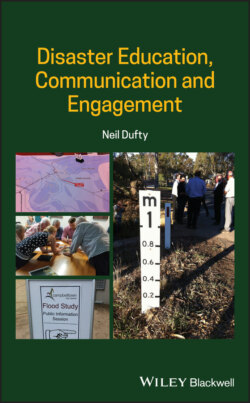Читать книгу Disaster Education, Communication and Engagement - Neil Dufty - Страница 9
2.1.2 Modes of Disaster Education
ОглавлениеThe International Standard Classification of Education 2011 (United Nations Educational, Scientific and Cultural Organization 2012) identifies four modes of education that are all applicable to a study of disaster education:
1 Formal education. ‘Formal education is education that is institutionalised, intentional, and planned through public organisations and recognised private bodies, and – in their totality – constitute the formal education system of a country.’ For disaster education, this would include curriculum-based learning in schools and universities. ‘Programs that take place partly in the workplace may also be considered formal education if they lead to a qualification that is recognised by national education authorities (or equivalent).’
2 Non-formal education. This is education that is ‘institutionalised, intentional, and planned by an education provider’ – sometimes called ‘extra-curricular activities’ – and is still related to the formal education system. For disaster education, it could be a safety demonstration to schools or a Massive Open Online Course (MOOC) linked to a university. ‘It is typically provided in the form of short courses, workshops or seminars.’
3 Informal education. ‘Informal learning is defined as forms of learning that are intentional or deliberate, but are not institutionalised.’ ‘Informal learning may include learning activities that occur in the family, workplace, local community and daily life, on a self-directed, family-directed or socially-directed basis.’ Examples of informal learning related to disaster education include using social media to learn more about a disaster, attending a community meeting called after an emergency, and participating in an emergency training course.
4 Incidental or random education. These are ‘various forms of learning that are not organised or that involve communication not designed to bring about learning’. They ‘may occur as a by-product of day-to-day activities, events or communication that are not designed as deliberate educational or learning activities’. This type of learning could include watching or listening to a news broadcast that includes details of a disaster, receiving an early warning emergency message, or reading an article about emergency preparedness in a magazine.
As part of lifelong learning, people may learn across the four different modes of education. Generally, formal and non-formal education is more experienced by those under 30 years old. Both informal and incidental education is obtained by all ages.
Shaw et al. (2011) conducted a literature review of global disaster education activities in the categories of formal, non-formal, and informal education. Most of the disaster education activities they reviewed were either in the formal or non-formal modes. This trend is supported by the majority of disaster education research being in the school setting (Chapter 11).
However, informal education has particular appeal to disaster learning for all ages. Informal education can occur in a range of settings such as the home, school, job, and in small groups such as community organisations (Knowles 1950). It is viewed as a critical component of lifelong learning (Hager 2001).
According to Feng et al. (2018), informal learning makes it easier to appreciate how disaster education ‘can be integrated into community and community processes, particularly with regard to the need to personalize education in ways that facilitate its applicability to the local contexts in which people experience hazard events’.
